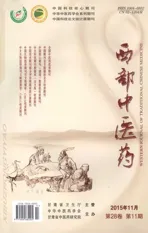以柴葛解肌汤为例探讨中医方剂英译的方法与技巧*
2015-02-22徐海女
胡 艳,徐海女,张 斌
南京中医药大学外国语学院,江苏 南京 210000
以柴葛解肌汤为例探讨中医方剂英译的方法与技巧*
胡 艳,徐海女,张 斌△
南京中医药大学外国语学院,江苏 南京 210000
以柴葛解肌汤为例探讨中医方剂的翻译方法和技巧,指出通过举例、说明等方法,将不同翻译方法和技巧运用到方剂翻译的实践中去,保障中医方剂翻译的规范性与准确性,以期达到理论指导实践的目的,进一步推动中医国际交流。
中医方剂;柴葛解肌汤;英译;规范
方剂是在辨证立法基础上,按照一定组方原则,将药物有机地组合在一起,用于防治疾病的制剂,是我国传统中医药的重要组成部分,其翻译的质量水平在一定程度上影响着中医药的对外交流。为保证翻译质量,提高翻译水平,防止胡译乱译现象,现以柴葛解肌汤为例探讨方剂翻译的方法、技巧,使译文更具规范性、科学性、合理性。
1 方剂的构成要素及其英译思路
方剂一般由方名、来源、组成、用法、功用、主治、加减、方解、使用注意等几个部分组成。一般而言,中药方剂学翻译中,功用、主治等的翻译可以套用一些既定的翻译模式,所涉及的问题可按照中医翻译的一般方法解决。现以解表剂中的柴葛解肌汤为例,依次讨论方剂的方名、来源、组成、用法、功用、主治、加减、方解、使用注意等方面的英译技巧和方法。
2 方剂各部分的翻译方法与技巧
“方名”部分的翻译有3个原则:间接性原则、信息性原则、回译性原则,这要求中医方名具有简明扼要、信息性并能直接将英文回译成中文的特点,使人一目了然、见词明义并实现信息的双向传递,又能提高翻译质量并限制滥译[1]。从翻译原则和实践分析,方剂名称英译以直译、音译为主,意译、释义为辅,由于中药译为拉丁文一般都比较长,不符合简洁性原则,为便于教学及与外国留学生更好地交流,临床上较多采用音译法,此种译法的缺点是译文中无法看出药物的功效、主治等;较正式的文章、资料等一般采用音译与意译相结合的译法,意译用括弧括起来。如本方柴葛解肌汤可译为ChaiGe JieJiTang(Bupleurum and Pueraria Decoction for Relieving Muscle)
直译法适合于以下几种命名法[2]:
1)以方中君药命名的方剂,译式为:君药+剂型名,如:
桂枝汤:Ramulus Cinnamomi Decoction
白头翁汤:Pulsatilla Decoction
2)以主治病症命名的方剂,译式为:病症名+剂型名,如:
三痹汤:Triple Arthralgia Decoction
肾着汤:Kidney Fixity Decoction
3)以治疗方法命名的方剂,译式为:病名+治法+剂型名,如:
透脓散:Pus-Expelling Powder
血府逐瘀汤:Blood Stasis Expelling Decoction
4)以借喻法命名的方剂,译式为:借喻物+剂型名,如:
碧玉散:Jasper Jade Powder
舟车丸:Vessel and Vehicle Pill
5)以功效命名的方剂,译式为:功效+剂型名,如:
抗白喉合剂:Anti-Diphtheria Mixture
大安丸:Great Tranquility Pill
6)以主药加功效命名的方剂,译式为:主药+剂型名+for+功效,如:
葶苈大枣泻肺汤:Lepidium/Descurainiae and Jujube Decoction for Draining Lung
羌活胜湿汤:Notopterygium Decoction For Drying Dampness
7)以服药时间命名的方剂,译式为:时间+剂型名,如:
鸡鸣散:Rooster-crowing Powder
8)以颜色命名的方剂,译式为:颜色+剂型名,如:
碧玉散:Green Jade Powder
紫雪丹:Purple Snow Elixir
一般情况,凡是不宜于直译的方剂,均可音译,翻译时,应先考虑直译,如果直译行不通,可采用音译,适合于音译的方剂名称有以下几种:
1)以方中所含诸药的组成命名的方剂,由于中药拉丁语较长,如果一个方剂名称中含有两个以上的中药名,如果逐个译出,方剂名称会比较长,不便于交流。如半夏白术天麻汤,音译为BanXia BaiZhu TianMa Decoction
2)以比喻、传说或五行配设相关的方剂名称,基于中西方文化差异性,中医文化的缺省以及语言国情学的事实,对于一些有中国特色的符号,难于找到相对应的英文,造成语言的不可译性,可以采取音译的方法,即归化原则,保持中医特色[3]。如真武汤,音译为ZhenWu Decoction.
直译名称时,应注意不能译成主谓结构式,尽量不用冠词、剂型名直接置于主药或病症之后,以便省去介词。音译时,应注意以词为单位,不是以字为单位,如仙方活命丹,应译为XianfangHuoming Bolus,并非译为XianFang HuoMing Bolus。同时,方剂名称中的剂型一般应直译。
“方源”部分的翻译牵扯到书名的翻译,考虑到回译性,中医书名的翻译,一般采用音译与意译相结合的方法,中间用连词or隔开,书名一律为斜体,实词部分首字母大写,方源一般译为source,如柴葛解肌汤来源《伤寒六书》,英译为Source:ShangHan LiuShu or Six Volumes of Book on Treatise Exogenous Febrile Diseases
“成分”或“组成”一般译为“ingredients”,而非“composition”,前者是指中药若干药物以混合物形式出现,后者侧重指化学成分,对于中药名的翻译采取拼音加拉丁文的形式,拼音是为了保持回译性,拉丁文是为了符合国际惯例,一般为斜体。柴葛解肌汤的“成分”部分翻译如下:成分:柴胡6 g,干葛9 g,甘草3 g,黄芩6 g,羌活3 g,白芷3 g,芍药6 g,桔梗 3 g,(原方未注明剂量)。
Ingredients:Chaihu(Radix Bupleuri)6 g,Gange(Radix Puerariae Lobatae,dried)9 g,Gancao (RadixetRhizomaGlycyrrhizae)3g,Huangqin(Radix Scutellariae)6 g,Qianghuo(Rhizoma et Radix Notopterygii)3g,Baizhi(RadixAngelicaeDahuricae)3 g,Shaoyao(RadixPaeoniaeAlba;RadixPaeoniaeRubra) 6 g and Jiegeng(Radix Platycodonis)3 g,(The dosage not marked in the original formula).
成分部分的某些药名后括号里加注有“先煎”“后下”“包煎”“另煎”“炒”“捣碎”“酒洗”“麸炒”“浸炒”等内容,可直接译成动词的过去分词以表示被动之意,如“decocted first,decocted later,wrapped boiling,decocted separately,parched,crushed,washed with wine,parched with bran,saturated and fried”等。
“用法”一词的翻译有 administration,usage,recommendation等,目前常见的翻译为ad ministration和usage,前者较为正式。“用法”部分的内容一般为“水煎服”,可译成祈使句“Decoct the ingredients in water for oral administration.”也有译为“All the above drugs are decocted together in water for oral administration.”比较而言,前者采用主动语态更流畅、自然、简洁。
“功用”一词不应译为functions,因为functions指人体、机械的功能,而方剂中的“功用”是指药物进入人体后产生的药理作用,所以应参考西医,翻译为actions。功用部分的内容一般为四字结构的中医术语,翻译时可处理成动名词结构。如该方“功用”部分的“发汗解肌,清泄里热”可译成“inducingdiaphoresis,relievingmuscle and clearing away internal heat.”
“主治”亦指“适应症”“主治”可译为indication,conditions,treatment,较常见的译为indication。主治部分的内容可处理成名词短语或词组形式。该方的“主治”部分的“外感风寒,郁而化热证。恶寒渐轻,身热增盛,无汗头痛,目疼鼻干,心烦不眠,咽干耳聋,眼眶痛,舌苔薄黄,脉浮微洪者。”[4]可译为“Syndrome of externally contracted wind-cold stagnated and transformed into heat,manifested by/as gradual relief of aversion to cold,gradually high body fever,anhidrosis,headache,eye pain, nasal dryness,disphoria with insomnia,dry throat,deafness,orbitalpain,thin and yellow tongue coating,floating,feeble and surging pulse.”
“加减”常译为modification,加减变化内容的句型一般为“(若)……者……宜加(减、去)……(以增强……之力)”,可处理成“For patients with(In case of)……add(remove)……(to enhance the potency of……)/…… can be added.”一般常用主动语态,句子更加简洁、流畅、自然、也符合英语语言表达习惯。
如该方中“若无汗而恶寒甚者,可去黄芩,加麻黄以增强发散表寒之力 (值夏秋可以苏叶代之);若表寒不甚,无恶寒头痛者,则去羌活、白芷;若里热盛,津伤口渴者,加重石膏用量,或加知母、花粉以清热生津。”可译为“In case of anhidrosis and severe aversion tocold, remove Huangqin (Radix Scutellariae),and add Mahuang(HerbaEphedrae)toenhancethe potencyofdispersingexteriorcold(In summer and fall,Suye(Folium Perillae)may be used as the substitute);in case of mild exterior cold without aversion to cold and headache,remove Qianghuo(Rhizoma et Radix Notopterygii)andBaizhi(RadixAngelicaeDahuricae); for patients with excessive interior heat, thirst with consumption of body fluid, increase the dosage of Shigao(Gyp sum Fibrosum),or add Zhimu(Rhizoma Anemarrhenae)and Huafen(Radix Trichosanthis)to clear away heat and generate fluid.”
“方解”主要分证治和方义两部分,证治部分论述证型、病因、病机、症状等,方义部分分别论述方中君、臣、佐、使药物的药性、归经、功用等,结尾部分综合评价该方的功效及临床意义。
根据该部分汉语的语言结构特点,证型部分常用“本方证为……所致。”“本方所治为……之证。”“本方主治……之证。”“本方所致之证,为……所致。”等,英译时可处理成“This formula is used for……syndrome caused by/due to……/或者This formula is a common formula to treat the syndrome of……”句型。采用被动语态以示客观性,处理成介词短语,使整个句子结构紧凑、逻辑缜密如该方“本方为治外感风寒,郁而化热的常用方”可译为“This formula is the common formula used for heat syndrome due to stagnation of externally contracted wind-cold.”
“病因病机部分”,语言凝练、言简意赅、语义丰富,有时间、因果等语义关系,故翻译时,可以将其处理为主从复合句,时间、结果状语从句,如“when……will……leading to(causing/giving rise to/resulting in,etc)”语义清晰,层次明了,同时使用as,with等引导伴随状语、同位语等成分,使得句子主干清晰。
如该方“外感风寒,本应恶寒重,发热轻,今恶寒渐轻,身热日盛,是为寒邪郁表,逐渐化热入里趋势所致。因表寒尚未全解,卫阳被遏,经脉不利,故头痛无汗,脉浮等症仍在。太阳表邪化热入里初犯少阳、阳明,故见心烦不眠,眼眶痛,咽干耳聋,鼻干,脉微洪等三阳合病之症。治当发汗解肌,兼清里热。”可译为“When externally contracted with wind and cold,patients usually feel severe aversion to cold and mild fever; however,in this case,pathogenic cold stagnates in exterior,and gradually transforms into heat,leading to gradual relief of aversion to cold and gradually high body fever;since exterior cold has not relived yet,defense Yang is checked and meridians are obstructed, resulting in headache, anhidrosis and floating pulse;when exterior pathogenstransformintoheattoinvade Shaoyang and Yangming meridians,they will bring out the symptoms and signs of complications of Taiyang,Shaoyang and Yangming meridians,such as disphoria with insomnia,orbital pain,dry throat,deafness,nasaldryness,feeble and surging pulse.The treatment lies in inducing hidrosis and reliving muscle,combined with clearing away internal heat.”
“方义解析部分”,可以使用adj.+n.+ed结构,构成复合形容词做定语,如 warm-natured,符合英语习惯,又简化句子成分;同时可使用介词with,as等引导的短语,作伴随状语或同位语,句子成分清晰明了,易于理解。
如该方“方用入少阳的柴胡疏畅气机,透少阳之热,入阳明的葛根发汗解表,解肌退热,共为君药。羌活散太阳表寒,白芷疏阳明风热,且二药均擅长止痛;黄芩、石膏助柴、葛清泄里热,四药共为臣药。白芍、甘草酸甘化阴,敛阴和营;桔梗宣利肺气,载药上行。诸药合用,寒温通用,以辛凉为主,共成辛凉解肌,兼清里热之剂。”可译为“In this formula,the Shaoyang-entering Chaihu(Radix Trichosanthis)smoothes Qi movement and clearing away heat from Shaoyang;the Yangmingentering Gegen (Radix Puerariae Lobatae) induces hidrosis and relieves muscles to remove fever; the two ingredients used together as the monarch medicinal.Qianghuo (Rhizoma et Radix Notopterygii)dissipates the exterior cold of Taiyang,while Baizhi(Radix Angelicae Dahuricae)expels wind and heat of Yangming,both of them good at reliving pain;Huangqin (Radix Scutellariae)and Shigao (Gypsum Fibrosum)assist Chaihu(Radix Trichosanthis)and Shigao(Gypsum Fibrosum)to clear away heat;the four ingredients used together as the minister medicinal.The sour and sweet-flavored Baishao(Radix Paeoniae Alba) and Gancao(Radix et Rhizoma Glycyrrhizae)transform and astringe Yin and mediate nutrient Qi;Jiegeng(Radix Platycodonis)ventilates the lung Qiand promotes the rise of medicinal.In this formula,cold-natured and warm-natured medicinal are used together, mainly composed of pungent-flavored and cool-natured medicinal to achieve the effects of reliving muscles and clearing away internal heat simultaneously.”
“使用注意”可以译成precautions,cautions等,其中前者较常见。常见的句型有It should be applied with caution(慎用);It is advisable to be used in……(宜用);It is unadvisable to be used in……(不宜用);It is contraindicated in……(禁用)。
如该方“注意事项:若太阳表证未入里,或未化热者,不宜用本方,恐其引邪入里。”可译为“Precautions:The formula is unadvisable to the case of exterior syndrome without entering the interior or not transformed into heat for the fear that it may lead to the pathogenic factors to enter the interior.
“现代应用”可以直译为modern application.该部分的内容”此方可用于治疗……者。“可用”The formula is applicable to……“句型。如该方”本方用于治疗感冒、流行性感冒等属外感风寒,邪郁化热证者。“可译为”The formula is applicable to common cold,influenza and so on,which belong to the syndrome of externally contracted wind-cold stagnated and transformed into heat.”
3 结束语
中医方剂是中医药的重要组成部分,方剂翻译在我国传统中医药对外交流方面起着举足轻重的作用[5]。由于缺乏统一的翻译标准、原则、技巧和方法,导致当前中医药翻译及方剂翻译混乱的局面,希望通过本文抛砖引玉,探讨方剂翻译的问题、技巧与方法,促使中医方剂翻译早日走上规范化、科学化道路。
[1] 李照国.中医英语翻译技巧[M].北京:人民卫生出版社,1997:12.
[2] 李照国.论中医方剂的翻译[J].中国科技翻译,1993,8(4): 23-26.
[3] 燕燕,张斌.从《黄帝内经》两个译本谈翻译的不可译性及其补偿法教学[J].时珍国医国药,2012,23(5):1267-1269.
[4] 李经蕴,史文君.中医方剂翻译规范与技巧探讨——《桑菊饮》为例[J].疯狂英语:教师版,2012(3):172-174.
[5] 陈德兴.方剂学[M].2版.北京:人民卫生出版社,2007:29.
English Translation Methods and Techniques of TCM Prescription with ChaiGe JieJi Tang as the Example
HU Yan,XU Hainu,ZHANG Bin△
Nanjing University of Chinese Medicine,Nanjing 210000,China
The paper discusses the English translation norms and techniques of TCM prescription with ChaiGe JieJi Tang(Bupleurum and Pueraria Decoction for Relieving Muscle)as the example based on the current situation of English translation of TCM prescription in order to ensure the standardization,accuracy and quality of TCM translation,thus further promote international exchanges of TCM by the means of examples and explanation to apply different techniques to real translation practice,thus achieving the effect of theory guiding practice.
TCM prescriptions;ChaiGe JieJi Tang;English translation;norms
R2-05
A
1004-6852(2015)11-0137-04
2014-11-27
江苏省高等教育教改课题基金项目(编号2013JSJG 228)。
胡艳(1989—),女,在读硕士研究生。研究方向:中医英语研究。
△通讯作者:张斌(1966—),男,硕士研究生导师,副教授。研究方向:中医外语、语言学教学及研究。
